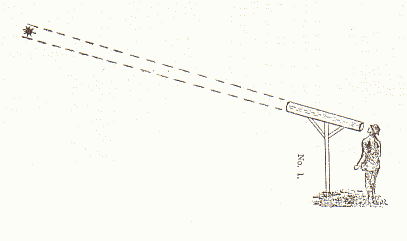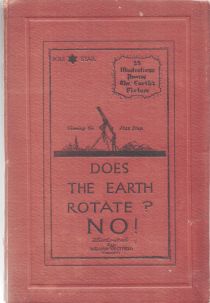In the compiling of this little book as a contradiction of the theory of the present Astronomers I have made a special point of being as concise and plain as possible in putting forward my proofs, and to do so I have used simple language not indulging in astronomical terms. My intention is to place all my facts in a plain and simple method so that all may conceive what I wish to prove, as the use of unnecessary terms and huge wording would only tend to puzzle and fog one in reading, hence I hope that those who peruse this book will be able to follow any argument and agree with my conviction that the earth is a fixture and the sun does certainly move.
Thus begins this uncommon little tract, by which William Westfield hoped in vain to persuade the “Educational Authorities” to abandon the idea that the earth rotates, or indeed moves at all, in space. The crux of his argument is based on a simple experiment performed in his garden, in which he placed a tube pointed at the Pole Star.

He says of it:
I have this tube fixed in my garden, size 3 feet 6 in. by 3/4 in., directed to the fixed pole star, and I can view the star continually. Why? Because the star is fixed in the heavens and because the earth is a fixture also.
His tube would have covered only just over one degree of arc of the sky, so actually he should have observed a little movement of Polaris, but presumably he was not really looking for it. His disbelief in the earth's rotation did not wholly rest on this single experiment, in any case:
Here is another positive proof that the earth cannot rotate. In the Desert of Sahara, the length from east to west is 3,000 miles, its average breadth 900 miles, and its area 2,000,000 square miles. Rain falls on this desert at intervals only of five to ten or twenty years. If the earth rotates over 10,000,000 miles daily [corrected in errata to a mere 1,555,200 miles a day - still too large by a factor of about 60!], and in addition makes another movement round the orbit and sun yearly how can this large desert escape the rain from the heavens for years at a stretch, while other places receive the rain regularly? Why? It is because this desert is a fixture, and is not favoured by rain from the heavens, like other places, owing to geographical conditions.
As recent as June, 1917, it rained for about one hour on my garden, and only two and a half miles from here, north, south, east and west, there was no rain at all.
His garden should be located and marked with a blue plaque to record its important role in the history of thought.
I would not want to address each of the many fallacies expounded in Westfield's book, though it may be of interest that he thought that the rotation of the earth that he was arguing against was like the rolling of a ball, with the north and south poles exchanging places twice daily, but I do think his attempt to justify a belief in a flat earth is worthy of some attention:

As I contend that our earth is practically flat except for the hills, mountains and valleys, that no such thing as a globe exists, readers may wonder why the sun is not on view all over the world at one time. My answer is as illustrated. No 1 is the position of the sun at mid-day, in June, in England. At the same time it is midnight in New Zealand, and the mountain, hill or horizon as shown at C would easily prevent a person in New Zealand at D from viewing the sun when over England.
No 2 is the sun at New Zealand in mid-winter and a person in England at A is prevented from viewing the sun at New Zealand after it has travelled from viewing across the heavens to that country. This is due to the mountains, hills, towns, villages or horizon at B obstructing the view. All readers are aware that mountains and hills and horizon are common in all countries, and therefore it is these that easily hide the sun from our view, although the sun is even at a high altitude at that place.
(Yes, those horizons get everywhere, don't they?) On this basis Westfield calculates the sun to be only 2,500 miles above the earth. Curiously, he omits to say exactly how it must move in relation to the flat earth below it, in order to give the relative timing and orientation of sunrises and sunsets that are actually observed throughout the world. But to do so would presumably be a simple exercise, given his confident conclusion to this volume:
There are [...] large sums of money spent annually at our Observatories throughout England on astronomy based upon Astronomers' opinion and enormous distances given by them, such as the distance of the earth to the pole star and sun of millions of miles, whereas ordinary mathematics as taught at schools daily, absolutely prove the distance in both cases to be less than 10,000 miles.
With all due respect to astronomers' prophesies of future happenings as to comets, readers will see their judgment as to distances and earth rotation cannot be relied upon. May I ask, is it worth while keeping a large staff at our Observatories, or anyone working at a false and unreasonable theory, especially when our Government has now definitely decided on economy at their establishments?
A considerable sum of money can now be saved by greatly reducing the staff at observatories in this country, and undoubtedly the Government will be convinced that the proofs given in this small book is [sic] overwhelming against the enormous distances given by astronomers, and that the earth rotation theory is absolutely disproved.
I wonder if the current British Government, given its documented willingness to accept dodgy evidence is yet ready to listen?

Alfred, thank you for
David, you are welcome to
David, you are welcome to them!
"as a general rule," it
the eath is round or we would
I didn't understand your
Earth was flat said the greek
This is the funniest page I
I have a photocopy of this
Thats your answer? I'm
Why should I answer anyone's
Why should I answer anyone's questions? I'm not here providing a public service.
When I don't know the answer to something, I do this thing called research. These days it's easier than it used to be, but I don't expect random strangers on the internet to give me all the answers, for nothing, without even the pretence of gratitude.
Unlike you, you [unnecessary insult written in heat of the moment removed].
Ta ta!
Why do astronomers say that
If I remember my college
Man, you are curious, aren't
Man, you are curious, aren't you? But also too lazy to look things up for yourself, I see,
Hi. Sorry I'm not a flat
Simple observation will show
Simple observation will show that the stars do move in the sky, albeit slowly. This is one of the reasons we know that our planet is moving. They don't move quickly because they are a very, very long way away. When you are driving alongside distant hills, don't they seem to move much more slowly than nearby trees? That is the same phenomenon on a smaller scale.
No, I don't think they are
Look, if you have ever been
no comments.......... anybody